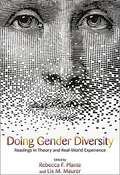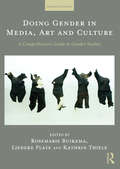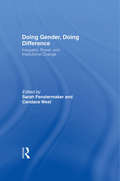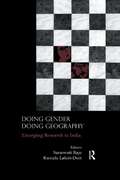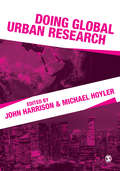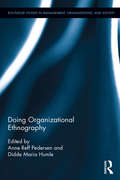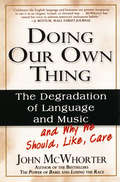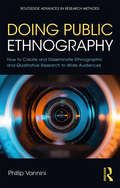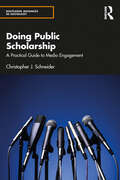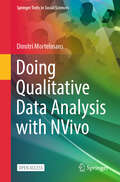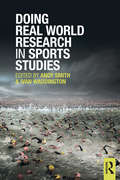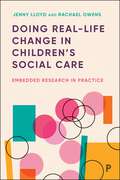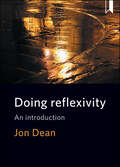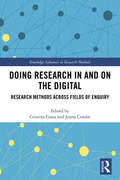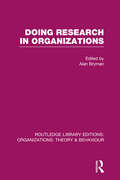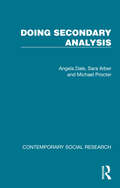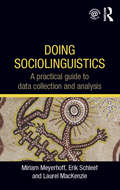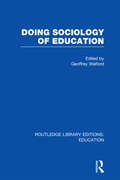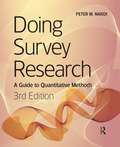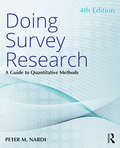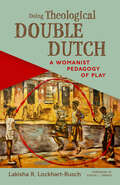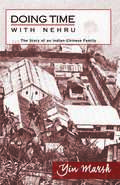- Table View
- List View
Doing Gender Diversity: Readings in Theory and Real-world Experience
by Rebecca F. Plante Lis M. MaurerThis cutting-edge reader demonstrates the multiple ways in which the universe of gender is socially, culturally, and historically constructed. The selections focus on gender itself—how gender operates socioculturally, exists, functions, and is presented in micro and macro interactions. In order to avoid balkanization, the authors examine the various ways in which culture intersects with individuals to produce the range of presentations of self that we call “gender,” from people born male who become adult men to lesbian women to transmen, and everyone else on the diverse gender spectrum.
Doing Gender in Media, Art and Culture: A Comprehensive Guide to Gender Studies
by Rosemarie Buikema and Liedeke Plate and Kathrin ThieleDoing Gender in Media, Art and Culture, 2nd edition is a comprehensive gender studies textbook with an international focus and relevance across a broad range of academic disciplines. Covering an array of topics, theories and approaches to gender studies, it introduces students to the study of gender through geographically diverse case studies on different historical and contemporary figures. The volume covers the established canon of gender studies, including questions of representation, standpoints and intersectionality. It addresses emerging areas including religion, technology and online feminist engagement, as well as complex contemporary phenomena such as globalization, neoliberalism and ‘fundamentalism’. Core figures ranging from Simone de Beauvoir to Gloria Anzaldua and from Florence Nightingale to Malala Yousafzai serve as prisms of gender-sensitive analysis for each chapter. This vibrant textbook is essential reading for anyone in need of an accessible yet sophisticated guide to gender studies today.
Doing Gender, Doing Difference: Inequality, Power, and Institutional Change
by Sarah Fenstermaker Candace WestFor the first time the anthologized works of Sarah Fenstermaker and Candace West have been collected along with new essays to provide a complete understanding of this topic of tremendous importance to scholars in social science.
Doing Gender, Doing Geography: Emerging Research in India
by Kuntala Lahiri-Dutt Saraswati RajuUntil the 1970s gender had been invisible in analyses of social space and place in the androcentric discipline of geography. While recent contributions to feminist geography have challenged this, in India the engagement of geographers with gender, by being conservative in its choice of focus and orthodox in methodology, has been unable to destabilise the established disciplinary order. However, with younger scholars becoming increasingly interested in studying gender in geography, novel and innovative methods that include combinations of quantitative and qualitative analyses, visual sources and in-depth case studies are being tried out and accepted in geography despite its masculine legacy. This pioneering study brings together Indian geographers’ contributions to understanding gender, and through them, seeks to enrich the discipline of geography. It engages with the recent ‘spatial turn’ in the social sciences, which has reclaimed the explanatory power of space and place in social theory that had been nearly lost to deconstructive postmodernist scholarship. The volume draws entirely from the Indian scholarship, showcasing contextualised knowledge production, but hopes to initiate a a dialogue with scholars elsewhere working with feminist methodologies.
Doing Global Urban Research
by John Harrison Michael HoylerWhether you are an urban geographer, an urban sociologist or an urban political scientist, and whether you take a qualitative, quantitative or mixed methods approach, the challenge that confronts researchers of our increasingly "globalized" urban studies remains fundamentally the same—how to make sense of urban complexity. This book confronts this challenge by exploring the various methodological approaches for doing global urban research, including Comparative Urbanism, Social Network Analysis, and Data Visualization. With contributions from leading scholars across the world, Doing Global Urban Research offers a key forum to discuss how the practice of research can deepen our knowledge of globalized urbanization.
Doing Global Urban Research
by John Harrison Michael HoylerWhether you are an urban geographer, an urban sociologist or an urban political scientist, and whether you take a qualitative, quantitative or mixed methods approach, the challenge that confronts researchers of our increasingly "globalized" urban studies remains fundamentally the same—how to make sense of urban complexity. This book confronts this challenge by exploring the various methodological approaches for doing global urban research, including Comparative Urbanism, Social Network Analysis, and Data Visualization. With contributions from leading scholars across the world, Doing Global Urban Research offers a key forum to discuss how the practice of research can deepen our knowledge of globalized urbanization.
Doing Organizational Ethnography: A Focus on Polyphonic Ways of Organizing (Routledge Studies in Management, Organizations and Society #38)
by Anne Reff Pedersen Didde Maria HumleThis book presents a new way of understanding organizational ethnography due to its strong emphasis on what the word organizational means in organizational ethnography. In the past five years, a new organizational studies research field has developed involving organizational ethnographies, which is when organizations are studied using ethnographical methods. This development has shed light on the methods and difficulties of organizational ethnography, and yet we argue that confusion still remains as to what organizational ethnographical approaches are. This edited volume offers students and scholars a profound understanding of organizational ethnography by presenting concrete examples, reflections and discussions of how to understand and adequately conceptualize the word organizational in organizational ethnography. All the chapters illustrate the work of analytically combining different organizational phenomena (e.g. strategy making, policymaking), analytical perspectives (e.g. sensemaking, narratives) and ethnographical methods (e.g. texts, observations, shadowing, interviews) and demonstrate different ways of doing organizational ethnography. At the end of each chapter, an experienced researcher in the field offers comments and discussion on the contributions of the chapter, providing reflections on the implications for research in the field to which they ascribe. In Doing Organizational Ethnography, organizational is defined as polyphonic ways of organizing based on the interactions of the many voices, discourses, practices and narratives in and around organizations and the book provides readers with in-depth reflections on what organizing and organizations become when doing organizational ethnography.
Doing Our Own Thing: The Degradation of Language and Music and Why We Should, Like, Care
by John McWhorterEncourages readers to establish a boundary between an acceptable evolution of language and outright language misuse, predicting the consequences of the overuse of street English in today's writing, music, and society. By the author of The Power of Babel. 50,000 first printing.
Doing Psychoanalysis in Tehran
by Gohar HomayounpourIs psychoanalysis possible in the Islamic Republic of Iran? This is the question that Gohar Homayounpour poses to herself, and to us, at the beginning of this memoir of displacement, nostalgia, love, and pain. Twenty years after leaving her country, Homayounpour, an Iranian, Western-trained psychoanalyst, returns to Tehran to establish a psychoanalytic practice. When an American colleague exclaims, "I do not think that Iranians can free-associate!" Homayounpour responds that in her opinion Iranians do nothing but. Iranian culture, she says, revolves around stories. Why wouldn't Freud's methods work, given Iranians' need to talk? Thus begins a fascinating narrative of interlocking stories that resembles--more than a little--a psychoanalytic session. Homayounpour recounts the pleasure and pain of returning to her motherland, her passion for the work of Milan Kundera, her complex relationship with Kundera's Iranian translator (her father), and her own and other Iranians' anxieties of influence and disobedience. Woven throughout the narrative are glimpses of her sometimes frustrating, always candid, sessions with patients. Ms. N, a famous artist, dreams of abandonment and sits in the analyst's chair rather than on the analysand's couch; a young chador-clad woman expresses shame because she has lost her virginity; an eloquently suicidal young man cannot kill himself. As a psychoanalyst, Homayounpour knows that behind every story told is another story that remains untold. Doing Psychoanalysis in Tehran connects the stories, spoken and unspoken, that ordinary Iranians tell about their lives before their hour is up.
Doing Public Ethnography: How to Create and Disseminate Ethnographic and Qualitative Research to Wide Audiences (Routledge Advances in Research Methods)
by Phillip VanniniEthnography and qualitative research methodology in general have witnessed a staggering proliferation of styles and genres over the last three decades. Modes and channels of communication have similarly expanded and diversified. Now ethnographers have the opportunity to disseminate their work not only through traditional writing but also through aural, visual, performative, hypertext, and many diverse and creative multimodal documentation strategies. Yet, many ethnographers still feel insufficiently proficient with these new literacies and opportunities for knowledge mobilization, and they therefore still limit themselves to traditional modes of communication in spite of their desire for innovation. As university-based, community-driven and politically mandated agendas for broader knowledge transfer keep increasing worldwide, the demand for public scholarship continues to grow. Arguing for the need to disseminate innovative ethnographic knowledge more widely and more effectively, this book outlines practical strategies and tools for sharing ethnographic and qualitative research through widely accessible media such as magazines, trade books, blogs, newspapers, video, radio, and social media. Drawing from practical experiences and hands-on lessons, Doing Public Ethnography provides social scientists across all disciplines with concrete tactics for mobilizing knowledge beyond the academic realm.
Doing Public Scholarship: A Practical Guide to Media Engagement (Routledge Advances in Sociology)
by Christopher J. SchneiderA basic premise of public scholarship is making academic work and related ideas accessible and available to publics. Media engagement, whether interviews with news journalists, or the use of hashtags, is a necessary feature of any public scholarship. Media formats play a fundamental and interactive role in how people ultimately come to view and understand the social world, having had a discernable influence on election outcomes, responses to global pandemics, and so on. The question is not whether scholars should engage with media but how to do so. Drawing on fifteen years of experience that includes hundreds of print, radio, and television news interviews, dozens of published opinion pieces, and the use of social media for public engagement, this book outlines a practical, easy-to-follow approach to doing public sociology in media that consists of, and brings together, interrelated forms of media engagement. This book also offers some advice pertaining to career advancement and provides strategies to avoid negative experiences. Doing Public Scholarship will be of general interest to those wanting to go public with their research.
Doing Qualitative Data Analysis with NVivo (Springer Texts in Social Sciences)
by Dimitri MortelmansThis open access textbook provides an introduction to the software program NVivo, the most widely used qualitative analysis program. It is a versatile program with an extensive range of accessible analysis tools, flexibly deployable in the diversity of qualitative analysis approaches. Qualitative analysis is almost standard practice today with the help of a software program. Yet there are many misunderstandings about qualitative software. They support the qualitative researcher but never take over their manual and theoretical work. An in-depth understanding of the possibilities of a qualitative software program helps to free up time for the analysis itself. The possibilities of NVivo in this book are approached from a researcher's perspective. That is precisely why gaining efficiency in using the software tools gets a prominent place in the chapters. The author examines basic skills, such as managing data, working with memos and coding qualitative data. This includes textual data (such as transcripts from interviews and focus groups) and audiovisual material (sound, video and images). The book also discusses more advanced analysis tools, such as case coding, queries, AI tools, matrices and models (maps). This textbook is intended for all users of NVivo, both early career researchers and more advanced analysts, who want to further discover the secrets of this software package along the way.
Doing Real World Research in Sports Studies
by Andy Smith Ivan WaddingtonTraditional research methods textbooks tend to present an idealized and simplistic picture of the research process. This ground-breaking text however, features leading international sport researchers explaining how they actually carried out their real life research projects, highlighting the practical day-to-day problems, false starts and setbacks that are a normal part of the research process. This book focuses on ten pieces of research that have made a distinctive and valuable contribution to the study of sport. For each one the author of that research explains how the project was conducted and the issues that they faced. In addition, each piece of research has a commentary from a leading sport scholar outlining why it is regarded as being an important contribution to the discipline of sport studies and how that research can inform studies being carried out today. Contributors to the book describe how in their own real life research projects, they initially conceptualized and defined their research projects secured funding and/or sponsorship from relevant bodies handled enforced changes to the research plans confronted/overcame obstacles presented by outside bodies managed inter-personal/emotional relationships in the research encounter managed possible threats to their personal safety or physical integrity managed good luck, bad luck and serendipitous findings dealt with favourable and hostile media reaction to research findings. Doing Real World Research in Sport Studies enables students and researchers to develop a more realistic understanding of what the research process actually involves. It charts the development of key research projects in sport and should be essential reading for any sport research methods course.
Doing Real-Life Change in Children’s Social Care: Embedded Research in Practice
by Jenny Lloyd Rachael OwensAll too often, human systems are criticised for failing those they are meant to serve. One example is the growing awareness of the overlooked needs of adolescents facing harm in their communities. This has highlighted a need for new systems that enable practice that is ethical, effective and grounded in supportive relationships. But how can this be achieved? Appealing to those interested in Contextual Safeguarding and beyond, this book shares ‘real-life’ lessons from research, covering: • Practical guidance and tools for changing systems using embedded methods; • Navigating complex relationships and emotions in organisational change; and • Using theory and concepts to support change. The book’s lively and creative style makes it accessible for researchers, students, professionals and anyone committed to system change in children’s social care.
Doing Reflexivity: An Introduction
by Jon DeanReflexivity is vital in social research projects, but there remains relatively little advice on how to execute it in practice. This book provides social science researchers with both a strong rationale for the importance of thinking reflexively and a practical guide to doing reflexivity within their research. The first book on the subject to build primarily on the theoretical and empirical contributions of Pierre Bourdieu's reflexive work, it combines academic analysis with practical examples and case studies, drawing both on recent reflexive research projects and original empirical data from new projects conducted by the author. Written in an engaging and accessible style, the book will be of interest to researchers from all career stages and disciplinary backgrounds, but especially early-career researchers and students who are struggling with subjectivity, positionality, and the realities of being reflexive.
Doing Research In and On the Digital: Research Methods across Fields of Inquiry (Routledge Advances in Research Methods)
by Cristina Costa Jenna CondieAs a social space, the web provides researchers both with a tool and an environment to explore the intricacies of everyday life. As a site of mediated interactions and interrelationships, the ‘digital’ has evolved from being a space of information to a space of creation, thus providing new opportunities regarding how, where and, why to conduct social research. Doing Research In and On the Digital aims to deliver on two fronts: first, by detailing how researchers are devising and applying innovative research methods for and within the digital sphere, and, secondly, by discussing the ethical challenges and issues implied and encountered in such approaches. In two core Parts, this collection explores: content collection: methods for harvesting digital data engaging research informants: digital participatory methods and data stories . With contributions from a diverse range of fields such as anthropology, sociology, education, healthcare and psychology, this volume will particularly appeal to post-graduate students and early career researchers who are navigating through new terrain in their digital-mediated research endeavours.
Doing Research in Organizations: Organizations: Doing Research In Organizations (Routledge Library Editions: Organizations)
by Alan BrymanThis textbook provides first-hand, inside accounts of the process of doing research in organizations. It is intended both for students of research methods in sociology and social psychology, and for students of organization studies, organizational behaviour and management. The contributors tackle such problems as: gaining access to organizations, ‘getting on’ in organizations, quantitative and qualitative styles of investigation, the use of historical materials, the effects of resources on the context of research, the part played by political factors in organizational research, the relevance of grounded theory and conducting research within a cross-cultural framework.
Doing Secondary Analysis (Contemporary Social Research)
by Angela Dale Sara Arber Michael ProcterOriginally published in 1988 Doing Secondary Analysis is a practical guide to the secondary analysis of large-scale survey data.At a time when funding for primary data collection was increasingly constrained, the secondary analysis of high-quality government surveys offered the social scientist an unrivalled opportunity. This volume provided a guide which moves through every stage of ‘doing secondary analysis’. The authors begin with the conceptualization of the research problem and examine all the practicalities of using both standard rectangular data and hierarchical data, and of deriving simple and complex variables. They also provide a lucid description of the hardware and software available to the secondary analyst at the time.This book successfully demonstrates the way in which secondary analysis can contribute both to the development of sociological theory and to social policy formation. The authors emphasize throughout that secondary analysis cannot be used as a short cut to quick ‘results’, but that as much care over defining the research problem and understanding the categories of data is needed as for any other kind of research.While Doing Secondary Analysis was invaluable to those about to embark upon social research, it also offered many challenges to more experienced researchers.
Doing Sociolinguistics: A practical guide to data collection and analysis
by Miriam Meyerhoff Erik Schleef Laurel MacKenzieDoing Sociolinguistics: A practical guide to data collection and analysis provides an accessible introduction and guide to the methods of data collection and analysis in the field of sociolinguistics. It offers students the opportunity to engage directly with some of the foundational and more innovative work being done in the quantitative or variationist paradigm. Divided into sixteen short chapters, Doing Sociolinguistics: can be used as a core text in class or as an easy reference whilst undertaking research walks readers through the different phases of a sociolinguistic project, providing all the knowledge and skills students will need to conduct their own analyses of language features excerpts from key research articles; exercises with real data from the authors’ own research; sample answers to the exercises; and further reading is supported by the Routledge Sociolinguistics Companion website (www.routledge.com/textbooks/meyerhoff) which features further online exercises with sound files. Designed to function as both a core text for methods classes in sociolinguistics and as a companion to the Routledge textbook Introducing Sociolinguistics, this book will be essential reading for all students studying and researching in this area.
Doing Sociology of Education (Routledge Library Editions: Education)
by Geoffrey WalfordThis collection of specially commissioned articles exposes the practical and personal influences on the process of doing sociology of education. All of the authors have been involved in conducting well know major research projects, and discuss here the pitfalls and problems, conflicts and compromises that went into doing their particular research. A particular feature of the book is that a wide variety of types of research in the sociology of education is covered. The range is from small-scale ethnographic case studies to large-scale postal questionnaire sample surveys and includes studies based on interviews, observation and questionnaires. There are examples of longitudinal work in case studies and in surveys. The collection also includes discussions of action research, the development and influence of theory, and the relationship between research and policy.
Doing Statistical Analysis: A Student’s Guide to Quantitative Research
by Christer ThraneDoing Statistical Analysis looks at three kinds of statistical research questions – descriptive, associational, and inferential – and shows students how to conduct statistical analyses and interpret the results. Keeping equations to a minimum, it uses a conversational style and relatable examples such as football, COVID-19, and tourism, to aid understanding. Each chapter contains practice exercises, and a section showing students how to reproduce the statistical results in the book using Stata and SPSS. Digital supplements consist of data sets in Stata, SPSS, and Excel, and a test bank for instructors. Its accessible approach means this is the ideal textbook for undergraduate students across the social and behavioral sciences needing to build their confidence with statistical analysis.
Doing Survey Research
by Peter M. NardiThe significantly updated third edition of this short, practical book prepares students to write a questionnaire, generate a sample, conduct their own survey research, analyse data, and write up the results, while learning to read and interpret excerpts from published research. It combines statistics and survey research methods in a single book.
Doing Survey Research: A Guide to Quantitative Methods
by Peter M. NardiEach day we are faced with continuing claims made by media pundits, politicians, teachers, and friends, often quoting research. Consider also the numerous comments and posts on Internet blogs, Twitter, and Facebook that illustrate the confusion between opinion and factual data. How do we learn to interpret the research we hear about and read, to distinguish opinions from scientific facts, and to use this knowledge to conduct our own studies to answer the questions faced in everyday situations? Understanding the components that go into scientific research and learning how to do research, make decisions about which statistics to use, and analyze statistical findings are goals for everyone in today's research-oriented world. Questions about the reliability and validity of data from a study or public opinion poll come up routinely and need critical review. This book contributes to achieving these objectives. Doing Survey Research is intended for people who want to learn how to conduct quantitative studies for a project in an undergraduate course, a graduate-level thesis, or a survey that an employer may want completed. This brief, practical textbook prepares beginners to conduct their own survey research and write up the results, as well as read and interpret other people's research. It combines survey design with data analysis and interpretation. And it is for those who need to understand and critically interpret survey research found in scholarly journals, reports distributed in the workplace, and social scientific findings presented online in the media, on a blog, or in social media postings. Essential new updates to this edition include coverage of Big Data, Meta-Analysis, and A/B testing methodology—methods used by scholars as well as businesses like Netflix and Amazon. New to this Fourth Edition Each chapter and its exercises feature updated data and illustrations from current academic and popular articles relevant to today’s web-oriented students, including studies focused on topics related to social media. Update web site http://doingsurveyresearch.wordpress.com/ New Coverage of Big Data (used by popular web sites like Amazon and Netflix) and the ethical issues which emerge not only about privacy, but also how it relates to the methods discussed in this book about sampling, probability, and research design. New coverage of meta-data, and the increasingly popular method in many professional and other settings.
Doing Theological Double Dutch: A Womanist Pedagogy of Play
by Lakisha R. Lockhart-RuschEmbodied womanist play brings us closer to ourselves, to others, and to the divine. In this remarkably innovative book, Lakisha R. Lockhart-Rusch offers a fresh vision for theological education rooted in the embodied insights of Black women. Acknowledging the historical reality that play has often been a privilege reserved for those in power, Lockhart-Rusch shows how play has nonetheless functioned as a hidden space of agency, healing, and resistance for Black women. Using the game of Double Dutch as an extended metaphor, she demonstrates how a womanist pedagogy of play offers a transformative encounter with the love of self and of God for students from all backgrounds. Coupling theory with practical tools, this book equips theological educators to teach across difference for the liberation of all.
Doing Time with Nehru: The Story of an Indian-Chinese Family
by Yin MarshThe midnight knock on the door and the disappearance of a loved one into the hands of authorities is a 20th-century horror story familiar to many destined to "live in interesting times." Yet, some stories remain untold. Such is the account of the internment of ethnic chinese who had settled for many years in northern india. When the Sino-indian Border War of 1962 broke out, over 2,000 chinese-indians were rounded up, placed in local jails, then transported over a thousand miles away to the Deoli internment camp in the Rajasthan Desert. Born in calcutta in 1949, and raised in Darjeeling, Yin Marsh was just thirteen years old when first her father was arrested, and then she, her grandmother and her eight-year-old brother were all taken to the Darjeeling Jail, then sent to Deoli. ironically, Nehru - India's first Prime Minister and the one who had authorized the mass arrests - had once "done time" in Deoli during india's war for independence. Yin and her family were assigned to the same bungalow where Nehru had also been unjustly held. Eventually released, Marsh emigrated to America with her mother, attended college, married and raised her own family, even as the emotional trauma remained buried. When her own college-age daughter began to ask questions and when a friend's wedding would require a return to her homeland, Yin was finally ready to face what had happened to her family.
